Table of contents
- Big curve ABS special Motorcycles with cornering ABS in comparison
- Sports driver faction disdained the safety gain for a long time
- Partly incomprehensible control behavior
- First system suitable for curves only in 2013
- Braking when driving straight ahead serves as a reference value
- KTM 1190 Adventure
- What about the KTM without cornering ABS?
- BMW S 1000 XR
- BMW also with top results in the wet
- Ducati 1299 Panigale S.
- Braking behavior designed to be aggressive
- Yamaha YZF-R1
- Cornering ABS is not a panacea for hearty anchoring in an inclined position
- The measurement setup
- The measurement data
- Braking diagrams
- This is behind the ABS obligation
- New rules from January 1st, 2016
- Studies confirm a high potential for accident prevention
- Overview of ABS legislation worldwide
- Interviews with Bosch and Continental
- MOTORCYCLE test result
- Used motorcycles with cornering ABS
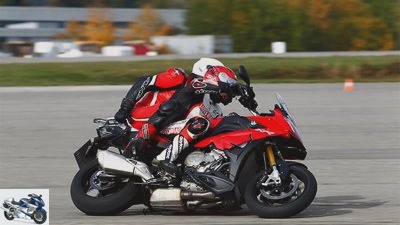
Photo: fact
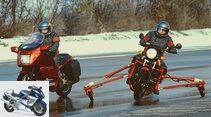
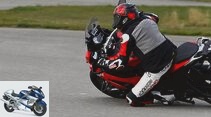
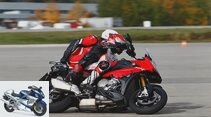
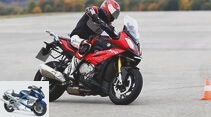
28 pictures
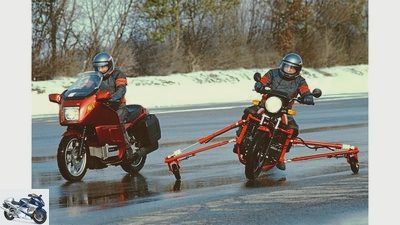
archive
1/28
BMW took on the pioneering role when it came to the spread of ABS in motorcycles. The following models want to show what is possible today. Not only straight ahead, but also in curves.
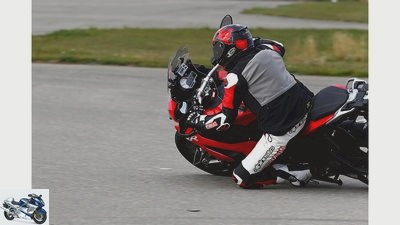
fact
2/28
“Pull right as hard as you want, as hard as you can” – the system regulates it precisely. 8.0 m / s² at an incline of 40 degrees is otherwise not achieved by any test person.
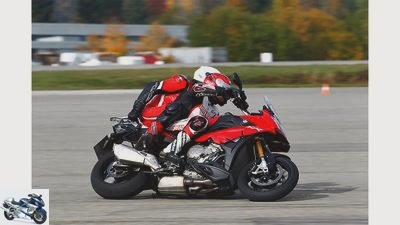
fact
3/28
… Even with a pillion passenger, there is serenity when anchoring.
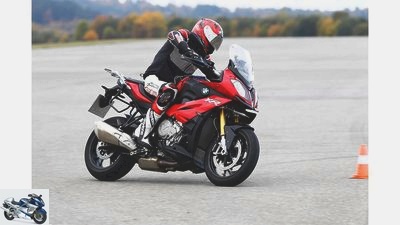
fact
4/28
The BMW S 1000 XR is not impressed by the lean angle, …
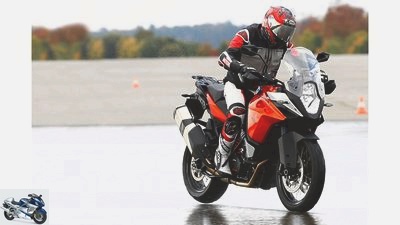
fact
5/28
The performance on a wet track was also examined.
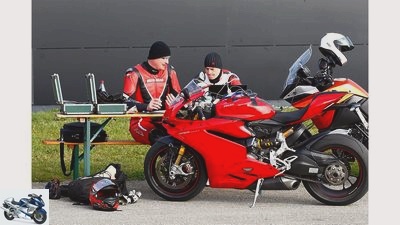
fact
6/28
After each series of measurements, author Jens Moller-Tollner (left) and top tester Karsten Schwers analyzed the results, calculated mean values and, if in doubt, tested again.
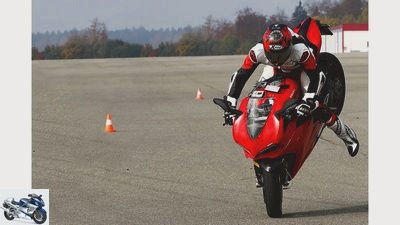
fact
7/28
… stands at right angles to the direction of travel.
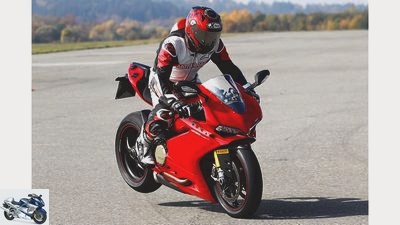
fact
8/28
… almost always with a stoppie. In extreme cases, the entire motorcycle turns and …

fact
9/28
the Ducati 1299 Panigale S with you? She acknowledges this undertaking from the curve …
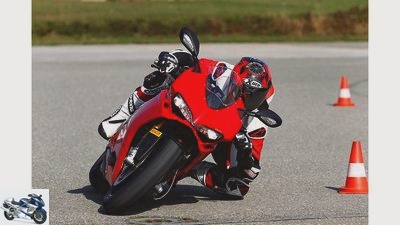
fact
10/28
Full lean angle – and then fully apply the brakes. How is doing …
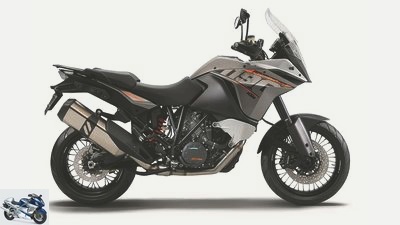
fact
11/28
KTM 1190 Adventure.
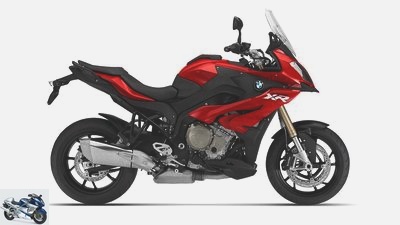
fact
12/28
BMW S 1000 XR.
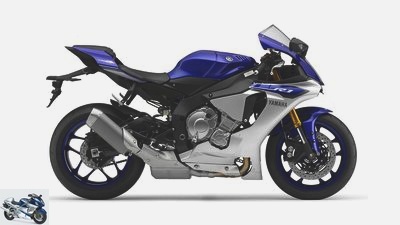
fact
13/28
Yamaha YZF-R1.
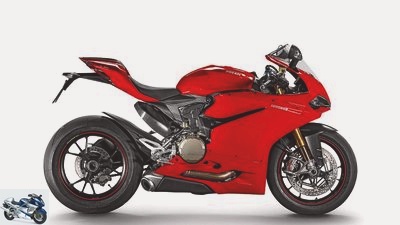
fact
14/28
Ducati 1299 Panigale S..
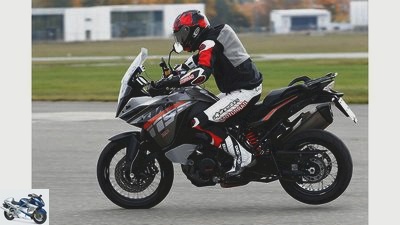
fact
15/28
The KTM 1190 Adventure was preferred to the 1290 sister as a representative of the popular travel enduro segment, as it offers two models: with normal and cornering ABS, and its anti-lock device can also be switched off.
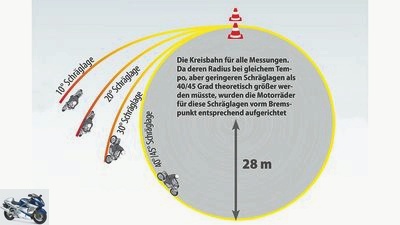
fact
16/28
The circular path for all measurements. Since their radius would theoretically have to be larger at the same speed, but at a lean angle less than 40/45 degrees, the motorcycles were set up accordingly for these lean angles in front of the braking point.
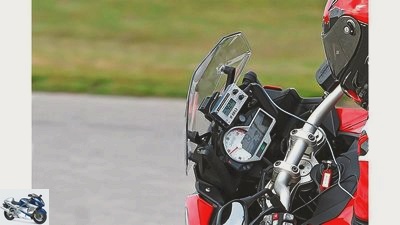
fact
17/28
The advantage of the tours? Top tester Karsten Schwers was perfectly able to rely on the
Include requirements for speed plus banking angle. Both parameters were permanently displayed to him during every test drive. If the conditions were right, he took full advantage of the brakes.
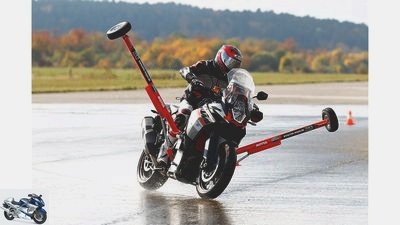
fact
18/28
… bend heartily with it. However, this vehicle was not used for the brake tests because of the atypical additional weight. Still an amazing experience.
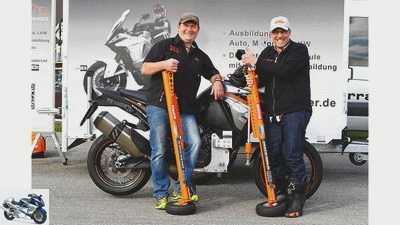
fact
19/28
Leaning position and braking in the wet: In order to approach the limits here, driving instructor Uli Strenger (left, mestraining.de) lent us his “lean angle trainer” built by KTM dealer Jurgen Mayer (ktm-mayer.de). The KTM 1190 Adventure settled in Neuhausen …
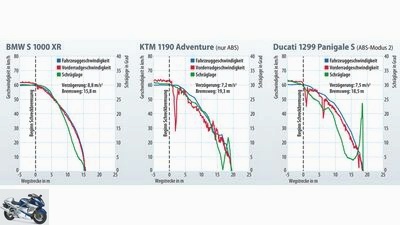
fact
20/28
As you can see, you don’t see anything: This is how you could describe the curves of the BMW S 1000 XR. Practically in line with the braking attempt at a 30 degree lean angle, the front wheel and vehicle speed decrease to a standstill. The ABS regulates finely, only allowing a little slip at the very beginning. A stable, safe delay. The KTM 1190 Adventure with ABS (no cornering ABS, middle) shows more spikes. Right at the start of the panic braking, the front wheel speed decreases by a good 50 percent compared to the vehicle speed. At a 30 degree lean angle, this results in a critical driving situation. And in the end the KTM has a stoppie. The green line for the lean angle is here because of the rising rear wheel. It gets even more extreme with the Ducati 1299 Panigale S with cornering ABS in mode 2. Three times as much slip on the front wheel, plus the rear is short and at the end really high. A maneuver that is difficult to master. The Ducati mode 2 is simply too aggressive designed for a panic braking.

fact
21/28
Measurement data: wet braking, braking distance / deceleration from 60 km / h.
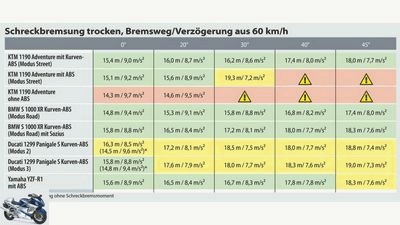
fact
22/28
Measurement data: dry start braking, braking distance / deceleration from 60 km / h.
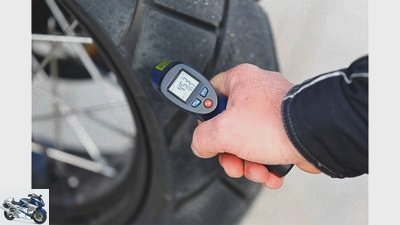
fact
23/28
Constantly stressed in the circular orbit, the tire shoulder gets really warm.
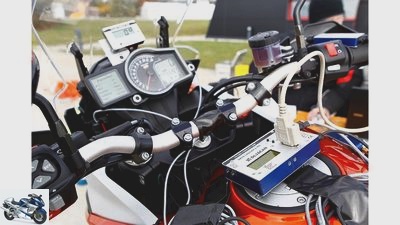
fact
24/28
Front wheel speed, lean angle, vehicle speed – everything can be read from the box.
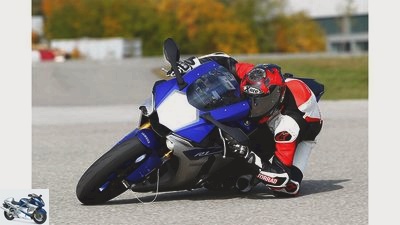
fact
25/28
The Nippon athlete manages the whole thing better than the Ducati. And that, although the Yamaha YZF-R1 does not have a so-called cornering ABS. At least Yamaha only calls it ABS with lean angle-dependent brake force distribution between the front and rear.
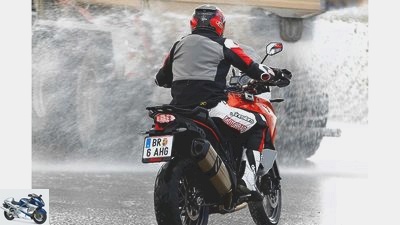
fact
26/28
By the way, you couldn’t be afraid of water during our tests in Neuhausen.
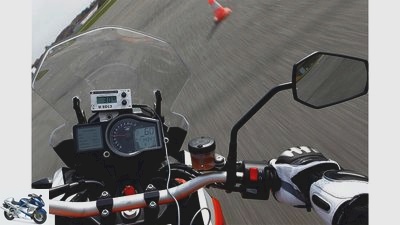
fact
27/28
You probably don’t necessarily want to swap with top tester Carsten Schwers, here on the 1190 Adventure.
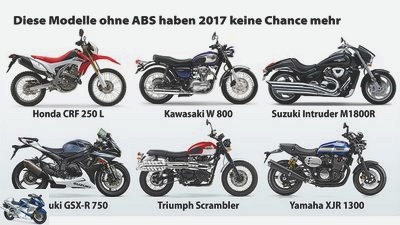
fact
28/28
From 2016 onwards, all new types of motorcycles must be equipped with improved braking systems; in the following year this will also apply to new registrations. This would mean that these six models would no longer have a chance.
counselor
Driving experience & Driving tips
Motorcycles with cornering ABS in comparison
Big curve ABS special
Motorcycles with cornering ABS in comparison
ABS helps in extreme situations. Recently also in curves. What is possible here? MOTORRAD investigated this question when testing various motorcycles with cornering ABS. Also included are the KTM 1190 Adventure, BMW S 1000 XR, Ducati 1299 Panigale S and Yamaha YZF-R1.
Jens Moller-Tollner
October 29, 2015
Before we get to the canned goods, a question: Do you dare to decelerate your ABS-free motorcycle safely and quickly in the event of pure shock braking? Getting everything out of the brakes? The honest answer would be no. Simply because it is almost impossible in extreme cases to keep the brake pressure in the ideal range, while simultaneously scanning the road for possible changes in the coefficient of friction with your eyes and at the same time keeping the load stable on course.
Buy complete article
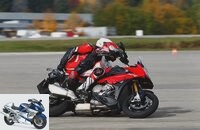
Big curve ABS special
Motorcycles with cornering ABS in comparison
12 pages) as PDF
€ 2.00
Buy now
Sure, some succeed, like Karsten Schwers, top tester at MOTORRAD. He doesn’t do anything else either. But it remains to be seen that it will also reach its limits. And because it is almost impossible to conjure up the perfect stopping distance on the floor in the moment of shock, anti-lock braking systems (ABS) have been helping since 1988.
Sports driver faction disdained the safety gain for a long time
MOTORRAD campaigned for their dissemination early on. Even against massive resistance. In places it was not so unfounded. Because although the first ABS components – in the BMW K 100 – knew how to prevent a fall over the front wheel when driving straight ahead, the braking systems themselves were rather undersized. Small discs, tiny pistons: there was better conventional material in the late 1980s and early 1990s. The sports driver group in particular disdained the safety gain for a long time.
After all, experienced drivers from GSX-R and the like, i.e. mostly experienced drivers, came to a standstill much sooner than with the first ABS motorcycles. But even back then that was only true if everything was right. Realizing the same braking distance umpteen times in succession, mastering a panic braking as safely as possible: this basic virtue was already closely linked to ABS motorcycles back then. And even today hardly anyone could and can guarantee this performance consistently and as safely as a standard anti-lock device.
Partly incomprehensible control behavior
In addition to the disadvantages already mentioned, facts such as high weight – a good ten kilograms as an extra on the K 100, for example – and the size of the individual components such as pressure modulator and control unit must not be forgotten. That also bothered the athletes’ faction massively in the first place. It was all about faster, easier, more powerful. With these requirements, ABS was a no-go for a long time. But not only sports freaks reprimanded the negative souvenirs of an ABS.
There were also skeptical tones in the MOTORRAD editorial team, despite the positive attitude towards the topic. They were based on personal experiences. Spontaneous loss of braking power on bumpy roads or incomprehensible control behavior caused one or two frowns and also bruises. By the turn of the millennium at the latest, however, ABS in motorcycles fulfilled the expectations placed on them in terms of control performance and deceleration performance.
First system suitable for curves only in 2013
One of the main reasons for this triumph was a simple fact: as the dimensions of the assemblies shrank, the weight became less and the stored control algorithms improved, the spread of ABS on motorcycles automatically increased. These are currently largely – with a few exceptions – equipped with an ABS. From 2017, ABS will even be mandatory for newly registered two-wheelers over 125 cm³.
We shed light on the background to this Page 9 “This is behind the ABS obligation”. One of the interesting things about ABS development over the last 30 years is that even back then it was not just about pure ABS-assisted braking at zero degrees, but immediately with the introduction of the first system, the question of when this one was also raised Has curve-compatible scope of functions. At that time, the colleagues still suspected that the first successor generation would already have this security plus. It then took a little longer before the first system suitable for bends came onto the market. 2013 entered the KTM 1190 Adventure the stage.
Braking when driving straight ahead serves as a reference value
A startle braking in an inclined position, can that go well? How do different motorcycles react in this tricky situation? In order to represent the full range of motorcycle models as possible, MOTORRAD put the following models to the test: KTM 1190 Adventure – as a representative of the popular travel enduro segment. Two models are available, with normal and cornering ABS, and their anti-lock device can be switched off. Therefore it was preferred to the 1290 sister. Also included: BMW’s S 1000 XR, which represents the genus of crossover models with 17-inch wheels. The portfolio is rounded off by Ducati 1299 Panigale S as well as the Yamaha YZF-R1. The Ducati has cornering ABS as standard, the Yamaha is equipped with an ABS combination braking system with lean angle detection. However: Although these vehicles reflect the most modern delay solutions, they only allow individual considerations. Suspension travel, heights of the center of gravity, wheel load distribution: These aspects are too different and sometimes depict extremes. Therefore, the results can only show tendencies and cannot be universally applied.
Since even top tester Karsten Schwers does not pull the brakes mercilessly if he does not know the reaction, the lean angle was gradually increased during the brake measurements. A startle braking when driving straight ahead served as a reference value. The starting speed for each braking process was set at 60 km / h, which is roughly the speed that often occurs when maneuvering through narrow country roads. In order to always find the right lean angle, which is determined by a lean angle sensor, and the target speed, which varies greatly due to the different rolling circumference of the tires when cornering and was therefore recorded by a GPS sensor, all participants walked a circular path with a radius of 28 meters. Tester Schwers used this to approach the required values. How the course was set up and how the measurements were made is shown in detail Page 6 “The measurement setup”.
KTM 1190 Adventure
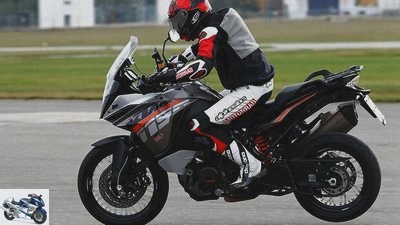
fact
KTM 1190 Adventure.
Enough of the preliminary skirmish now, those KTM 1190 Adventure with cornering ABS scratches its hooves. Straight ahead, with a braking distance of 15.4 meters from 60 km / h, it does not achieve a top value. What is noticeable: If the tester applies the brakes fully, slip occurs at first. Due to the long fork travel, the load on the front tire is initially lower.
The brake builds up pressure faster than the dynamic wheel load distribution shifts towards the front. A phenomenon that particularly affects long-legged enduros. Before the tire locks up, the ABS system reduces the brake pressure. Only when the fork has been compressed more and there is more load on the front wheel does the ABS increase the braking power again. The initial hatching phase is never a cause for concern, but it runs through all measurements. Overall, the KTM 1190 Adventure with ABS cornering does its job more than well, even on a 45 degree lean angle. 7.7 m / s², the only worry is to get your feet off the notches quickly enough not to fall over while standing. Even in wet conditions, the ABS-KTM doesn’t show any nakedness.
What about the KTM without cornering ABS?
It looks a little different with the KTM 1190 Adventure without cornering ABS. At the inclinations of zero and 20 degrees it is still slightly ahead of the sister model, but at 30 degrees it gets hairy. The slip on the front wheel rises sharply at the beginning of the measurement, the handlebars turn slightly in the same pull. In addition, the rear end strives upwards, which is why this KTM comes to a stop at the end with a stoppie. The braking behavior is just barely controllable by experienced drivers at this lean angle, but the unpredictability increases significantly with greater lean angles. There is a risk of falling. Because of the critical braking behavior at a 30 degree lean angle, MOTORRAD did not take measurements at greater lean angles, as a fall over the front wheel could hardly have been avoided. A comparison with the 1190 including ABS cornering shows how valuable the extended brake assistant can be in the event of a panic braking, how well the interaction between the ABS system, the data from the gyro sensor and the stored algorithms works. The software update for the 1190 Adventure at the KTM dealer to upgrade the normal ABS to a cornering ABS costs 399 euros plus working time. A good investment.
This is also made clear by the wet braking values. As in the dry, both KTM are initially on par, the pure ABS Adventure even has slight advantages. However, it reacts much more bitchy at a 20 degree incline, sovereign is different. The braking gets critical moves. The situation is similar with the KTM 1190 Adventure with deactivated ABS. The straight-ahead braking distance is the shortest, but it can only be achieved with a lot of experience. Here the right hand must take over the control behavior of an ABS. At an incline of 20 degrees, the pure values are still correct, but top tester Karsten Schwers makes every effort to keep the load on course. If you have an even greater incline, do you brake frightfully? Better not. Before people and material take soil samples, we break off. Here the end of the possible has been reached.
BMW S 1000 XR
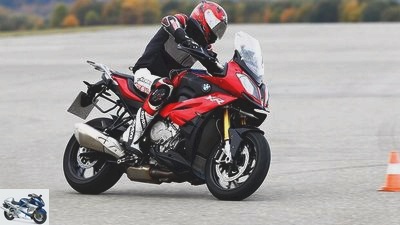
fact
BMW S 1000 XR.
Next up is the BMW S 1000 XR your turn. Stoic, good-natured, not to be shaken: the four-cylinder always gets the best out of the brakes and transfers a serenity when anchoring to the driver that is almost unbelievable. Pull right as hard as you want, as hard as you can – the system regulates it precisely.
8.0 m / s² at an incline of 40 degrees is otherwise not achieved by any test person. In order to conjure up this performance on the asphalt, the BMW S 1000 XR makes use of several perfectly coordinated factors.
BMW also with top results in the wet
Good components – from the brake system to the hydraulic unit to the software stored in the control unit – work hand in hand with an active chassis. If the KTM had an increased slip value on the front wheel at the beginning of the startle braking, this was almost completely absent with the BMW S 1000 XR. Shorter spring travel and fork damping that quickly adapts to the braking process ensure quietness and a full transfer of braking power. It doesn’t get any better than that.
The driver only hesitantly notices that the rear end tries to reach the sky. But at the moment when the wheel load on the front wheel feels too great, the ABS in the BMW reduces the front brake pressure by a few nuances. The stern sags slightly again. Overall, the BMW S 1000 XR offers a level of stability that the other test motorcycles cannot match. So in the end it is hardly surprising that the BMW delivers top values when it comes to deceleration even in the wet.
Ducati 1299 Panigale S.
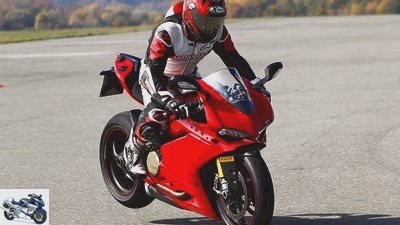
fact
Ducati 1299 Panigale S..
330 millimeter brake discs, fat brake pistons, radial brake pump at the front and cornering ABS: The Ducati 1299 Panigale S should be able to unlock the paper data for the BMW S 1000 XR or KTM 1190 Adventure. However, it only has the basic cornering ABS from Bosch, which is not designed as a composite braking system. A disadvantage? To evaluate the panic brake behavior of the 1299 Panigale S, it went through the tests in ABS modes 2 and 3. Mode 1 recommends Ducati only for use on the racetrack, as the ABS is then only active at the front. Even straight ahead, it becomes clear that the Panigale offers the potential for excellent braking values, but that this cannot be fully exploited in the event of a panic braking. why?
Because the Ducati 1299 Panigale S stands mercilessly on the front wheel in mode 2. Ducati’s IMU (Inertial Measurement Unit), which monitors the angle of inclination of the motorcycle, gives the command to release the brake very late. The result is a constant up and down. In mode 3 this phenomenon occurs in a milder way, but it is not completely eliminated.
Braking behavior designed to be aggressive
The fact that the Ducati 1299 Panigale S thus misses the optimum is shown by the deceleration values that MOTORRAD was able to achieve with braking at the limit of the ABS control behavior. This is – depending on the mode – one to almost two meters shorter than that of the panic braking. The values of the individual measurements, illustrated here using the example of a 20 degree incline, are further evidence of the too aggressive braking behavior. In mode 2, the decelerations achieved range between the minimum value 7.7 m / s² and the maximum value 8.7 m / s². If mode 3 is activated, the bandwidth ranges from 7.2 m / s² to 8.4 m / s². For comparison: the second athlete, the Yamaha YZF-R1, the values are much more constant, move between 8.2 m / s² and 8.5 m / s².
This incalculable range of the Ducati’s deceleration performance means that even a panic braking on a straight stretch of the road with the Ducati 1299 Panigale S in ABS mode takes on 2 critical traits. This remains the case even with all delays in an inclined position. In mode 3 it works much better straight ahead, but in an inclined position the Duc makes the aggressive set-up a clear line through the requirement “Safe braking in corners”. It remains critical.
Yamaha YZF-R1
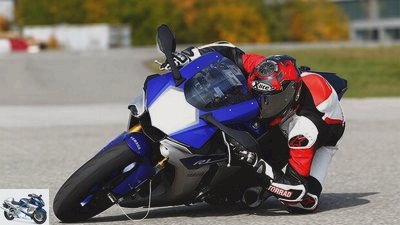
fact
Yamaha YZF-R1.
The values mentioned for the Yamaha already suggest that the Nippon athlete succeeds in the whole thing better than the Ducati. And that, although the Yamaha YZF-R1 does not have a so-called cornering ABS. At least Yamaha only calls it ABS with lean angle-dependent brake force distribution between the front and rear. So why does the YZF-R1 outperform the Ducati 1299 Panigale S? Because she acts much more defensively. Your ABS does not allow for peaks. Once it is fully in, the ABS immediately cuts excess brake pressure and immediately regulates it down. The slip on the front wheel is therefore very low at the first moment of deceleration.
Only when the front tire is properly loaded does the ABS also increase the braking power. On the face of it, this gives the impression that more and more is actually possible. At second glance, however, the values achieved make it clear that the Yamaha YZF-R1 does not move at the optimum through all inclines, but more than compensates for this nuance of lost braking performance with stable, safe and very confident braking behavior – this also applies to several Delays one after the other. Sports drivers on the race track may be bothered by it. In everyday life – especially in comparison to the Ducati 1299 Panigale S – this design appears to be clearly safer.
Cornering ABS is not a panacea for hearty anchoring in an inclined position
Only when the elbows are almost dragging over the asphalt, the Yamaha YZF-R1 pounds around the corner with a 45 degree incline, it behaves slightly critical in a startle braking. Then there is a lot of slip on the front wheel at first. The Yamaha quickly regains its lean angle due to the delay and comes to a manageable stop.
Five different models in the test and almost as many approaches to make braking in corners safer. Depending on the vehicle type and philosophy, manufacturers want to achieve this goal in different ways. This shows that cornering ABS is not a panacea for hearty anchoring in an inclined position. If the system is fine-tuned, it is undoubtedly a real gain in security.
The measurement setup
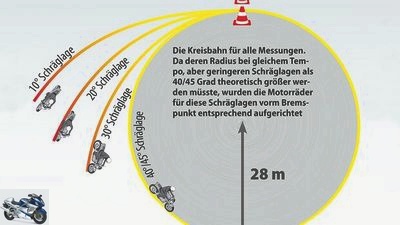
fact
The circular path for all measurements. Since their radius would theoretically have to be larger at the same speed, but at a lean angle less than 40/45 degrees, the motorcycles were set up accordingly for these lean angles in front of the braking point.
How are you supposed to decelerate different motorcycles at the same speed of 60 km / h at lean angles of 20, 30, 40 and 45 degrees with a panic braking so that meaningful measured values are obtained as a result? For this purpose, MOTORRAD built a circular path with a diameter of 56 meters on the test site in Neuhausen. The advantage of the tours? Top tester Karsten Schwers was able to focus perfectly on the requirements of speed plus lean angle. Both parameters were permanently displayed to him during every test drive. If the conditions were right, he pulled on the brakes. The position marked by the cones in the sketch was considered to be the same braking point for all.
Since it is impossible to always exactly match the speed and lean angle, the measured values were corrected mathematically in the case of slight deviations according to the specifications. The braking tests at inclines of 40 and 45 degrees could be implemented in the circular path; for all other incline measurements, the motorcycle was straightened before braking in order to achieve the required inclination. All motorcycles – with the exception of the athletes – also went through the procedure in the wet, whereby the lean angles were realistically limited to values of ten and 20 degrees. The braking distances achieved are based on mean values. Every motorcycle was measured at least three times in accordance with the lean angle specifications, in the case of large differences between individual braking processes even up to five times.
The measurement data
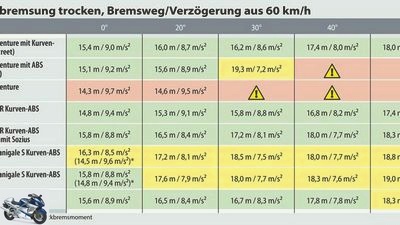
fact
Dry start braking, braking distance / deceleration from 60 km / h
Important: The test site in Neuhausen offers excellent grip. Only very few country roads have this. Therefore, the pure deceleration values are at a high level. This particularly applies to the braking performance achieved in the wet. Such stopping distances cannot be implemented in everyday life. Despite two irrigation with more than 7000 liters of water, the surface in Neuhausen proved to be extremely adhesive. On top of that, the constant circle driving caused the tires on the inside of the curve to heat up considerably. The infrared thermometer showed more than 50 degrees Celsius in places.
Tires do not reach this temperature when they are used in autumn and damp conditions, and their grip is correspondingly lower. For comparison: on clean, continuously watered wet test tracks with smoothly polished asphalt, cornering over 20 degrees of incline is often tricky. Therefore do not be blinded by the results. Since the conditions were the same for all motorcycles, the pure deceleration performance cannot be transferred one-to-one to everyday motorcycle life, but comparability with all strengths and weaknesses is guaranteed. And it is precisely these strengths and weaknesses that this comparison of different motorcycles with and without cornering ABS should highlight.
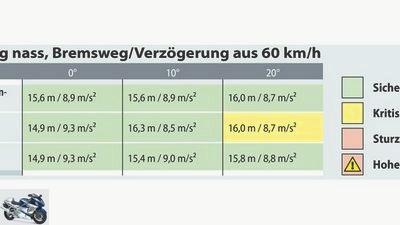
fact
Wet braking, braking distance / deceleration from 60 km / h.
In order to enable a quick visual classification of the results, they are highlighted with different colors. Red plus exclamation mark means: Caution, there is an acute risk of falling! Based on previous measurements, which indicated this tendency even at lower lean angles, MOTORRAD decided not to carry out any further tests. Red fields with measured values also represent braking attempts where there is an acute risk of falling. This applies, for example, to the KTM 1190 Adventure when driving straight ahead when ABS is deactivated. Yellow fields indicate: This is where it gets critical. This applies, for example, to the Ducati 1299 Panigale S in ABS mode 2, because it has a strong tendency to stop during all braking attempts or requires a lot of attention in an inclined position due to a twisting handlebar. Green fields indicate: everything is okay.
The BMW S 1000 XR in particular shows what is possible. When trying to push it to its limits, MOTORRAD was the only model to also test the Bavarian crossover model in pillion mode. But even the rear-heavy-looking extra package in the form of the author could not upset the BMW – Chapeau! The Yamaha’s performance is also remarkable. The Yamaha YZF-R1 is never ahead in terms of the measured values, but it still comes to a safe stop even at a 40 degree incline. And all of this without any excessive cornering ABS.
Braking diagrams
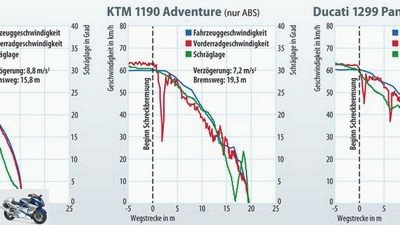
fact
Braking diagrams
The diagrams above demonstrate what can be read from the recordings of the front wheel and vehicle speed as well as the lean angle in relation to the distance traveled. As you can see, you don’t see anything: This is how you could describe the curves of the BMW S 1000 XR. Practically in line with the braking attempt at a 30 degree lean angle, the front wheel and vehicle speed decrease to a standstill. The ABS regulates finely, only allowing a little slip at the very beginning. A stable, safe delay. The KTM 1190 Adventure with ABS (no cornering ABS, middle) shows more spikes.
Right at the start of the panic braking, the front wheel speed decreases by a good 50 percent compared to the vehicle speed. At a 30 degree lean angle, this results in a critical driving situation. And in the end there is the KTM 1190 Adventure with a stoppie. The green line for the lean angle is here because of the rising rear wheel. It gets even more extreme with the Ducati with ABS cornering in mode 2. Three times as much slip on the front wheel, plus the rear is short and at the end really high. A maneuver that is difficult to master. The mode 2 of the Ducati 1299 Panigale S is simply too aggressive designed for a panic braking.
This is behind the ABS obligation

fact
These models without ABS have no chance in 2017.
From 2016 onwards, all new types of motorcycles must be equipped with improved braking systems; in the following year this will also apply to new registrations. Here you can find out what the new EU regulation means in detail, what consequences it has and whether there are any exceptions.
Road safety has been a top priority in the European Union since 2010. At that time, the EU Commission launched a program that aims to halve the number of road deaths by 2020. It was obvious that the adjusting screws should also be applied to two-wheelers – in view of 5000 motorcyclists killed in Europe in 2011 alone.
New rules from January 1st, 2016
The intended reform of the rules for type approvals came at just the right time to anchor “improved braking systems” for two-wheelers. In plain language, this initially vague formulation means: ABS will be mandatory for all newly developed motorcycles over 125 cm3 from January 1, 2016 across Europe. Smaller motorized two-wheelers with a displacement of more than 50 cm3 require a combined braking system (CBS) if ABS is not available. And after January 1, 2017, such new vehicles will no longer be registered without ABS or CBS.
But this can only be found in the long appendices of EU regulation 168/2013 “on the approval and market surveillance of two-, three-wheeled and four-wheeled vehicles”, which replaced the previous regulation 2002/24 on January 15, 2013. The almost 60-page set of rules was followed by four implementing ordinances that regulate details such as environmental compatibility and administrative issues. At the moment, however, the question of how to deal with individual approvals in the future is still open. This is likely to take place in further ordinances, as will the expected improvements to the rule 168/2013. One of the key points in the reformed type approval regulations for two-wheelers: The classification of vehicles is much more finely meshed. There are four classes with nine sub-categories: What has two wheels ranges from bicycles with an auxiliary engine (L1e-A) to fully-fledged motorcycles (L3e) to sideboards (L4e). Sport enduros and trial motorcycles also have their own categories (L3e-A1E / A2E / A3E and L3e-A1T / A2T / A3T).
Studies confirm a high potential for accident prevention
And that’s good. The reason: only such competitive machines are exempt from the ABS or CBS requirement, otherwise it will be tight for some manufacturers at the end of 2016. And not only exotic vehicles such as Benelli, Boss Hoss, Mash or Royal Enfield are affected, but also a number of established brands and models: There is no ABS for some athletes and cruisers. For example, but also not for the small Enduro CRF 250 L from Honda, for the chic retro model Kawasaki W 800 – and it is also missing from Suzuki’s supersport icon GSX-R 750. The same applies to the Yamaha XJR 1300. Hard to believe – was the air-cooled big block was completely revised for this model year.
Is the trendy, large-displacement four-cylinder perhaps being phased out? Then he would have a chance to be eligible for approval in 2017 as well. The new EU regulation has a small loophole: Manufacturers can apply for an extension of the deadline to the relevant national authorities – in Germany the Federal Motor Transport Authority – for series that are being phased out. They decide on this in each specific case. Or does the Yamaha XJR 1300 get ABS after all as part of a facelift? Yamaha in Germany does not yet have an answer to either of these questions.
The trend towards ABS is global. In addition to the EU, Brazil, Japan and Taiwan have already passed relevant regulations, and they are in preparation in the other major motorcycle markets. With good reason: Several international studies confirm that the system has a very high accident prevention potential. A study by the Allianz Center for Technology (AZT) already showed ten years ago that eight to 17 percent of serious motorcycle crashes could be prevented thanks to ABS and thus ten percent fewer fatalities would be mourned. A Bosch study from 2007 even assumes 26 percent fewer serious accidents.
Overview of ABS legislation worldwide
EU: ABS obligation for all motorcycles over 125 cm³ from 1.1.2016 for all new types and from 1.1.2017 for all new registrations
Japan: the same legal provisions as in the EU in terms of content; effective for all new types from October 1st, 2018 and from October 1st, 2021 for all current models
Taiwan: ABS obligation for all motorcycles over 126 cm³, ABS / CBS for all motorcycles under 125 cm3. Effective for all new types from 1.1.2019 and for all current models after 2021
Brazil: ABS obligation for all motorcycles over 300 cm³ from 2016 with an equipment rate of ten percent with a gradual increase to 100 percent in 2019
In preparation
USA: All motorcycles that are approved for use on highways must be equipped with ABS.
Australia: currently drafting a bill on ABS for motorcycles
China: ABS regulation is being drawn up. Expected to come into force in 2017
India: The Indian Ministry of Transport is planning to introduce mandatory ABS for all motorcycles over 125 cm³; Time still unclear.
Interviews with Bosch and Continental

Bosch, Continental
Jorg Kleemann, Head of Motorcycle Business, Vehicle Dynamics Business Unit at Continental (left) and Christian Groger, Application Manager Motorcycle Safety Systems at Bosch (right).
Bosch and Continental are taking a leading role in developing cornering ABS for motorcycles. Both are not resting on the status quo, but are already working on making motorcycling even safer in the future.
MOTORCYCLE: Cornering ABS is the latest development for perfect deceleration. What hardware and software is behind it??
Bosch: The lean angle-dependent ABS control is part of our motorcycle stability control MSC. The MSC hydraulic unit and the MSC control unit are based on our current ABS generation, the inertial sensor unit was specially developed for motorcycles. All hardware components as well as the software of the MSC systems are Bosch developments. The software is adapted to the respective motorcycle models in cooperation with the manufacturers.
Continental: The MK 100 generation of the integral brake, which has been in series production since 2012, serves as the basis at Continental. The motorcycle sensor box supplies the lean angle required for cornering. The development of the necessary components for cornering takes place in-house, the application of the system and the functions is done by the customer himself.
MOTORCYCLE: How is ABS systems integrated into the existing motorcycle infrastructure, which additional functions can still be implemented?
Bosch: Our MSC communicates with the wheel speed sensors, the inertial sensor unit, the engine control unit and the chassis. With the exception of the wheel speed sensors, communication takes place via the CAN bus. This enables functions such as lean angle-dependent ABS control, wheelie control and traction control. We can also better control the braking and acceleration forces, improve motorcycle stability and, for example, further shorten the braking distance in emergency situations.
Continental: The sensors that are already available today provide information on speed, braking pressures, rotation rates and accelerations. An extension with environmental sensors also provides information about people, vehicles, traffic signs and danger spots in the vicinity. The aim is to present functional improvements and extensions based on this information. These are driver assistance functions such as the emergency brake assistant and innovative software concepts such as the electronic horizon (eHorizon), which enables the intelligent and extended use of navigation data to control other vehicle systems. The aim is to significantly improve active safety.
MOTORCYCLE: Keyword potential for improvement – what is the focus of ABS for motorcycles?
Bosch: We have reduced the weight of our motorcycle ABS systems from more than four kilos to less than 700 grams over the past 20 years. At the same time, the control performance has improved significantly. One focus in the development of new systems will always be on reducing size and weight. The number of sensors will also increase. This will open up new possibilities.
Continental: Today’s ABS systems are very small. In detail, there is still potential to save weight and installation space. With the ABS control performance, however, a lot will happen, whereby an important component is to find a round and robust coordination of the ABS and the lift detection that can be easily and efficiently transferred to other vehicles.
MOTORCYCLE test result
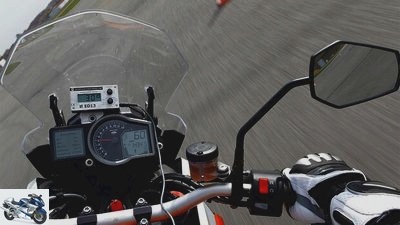
fact
When you are on a steep incline, fully grasp the iron – and the motorcycle comes to a safe stop.
Something is really going on there. When you are on a steep incline, fully grasp the iron – and the motorcycle comes to a safe stop.
What was until recently a case for the realm of myths is currently possible without any problems. BMW, KTM and Yamaha have shown that. What the test also made clear: Every motorcycle reacts differently to the startle braking in an inclined position. The results therefore provide valuable individual considerations and tend to show what cornering ABS can do. However, the data cannot be transferred to other vehicle concepts. New models with cornering ABS will follow. A good development so that more and more motorcyclists can master the panic braking in an inclined position as deceleration masters.
Used motorcycles with cornering ABS
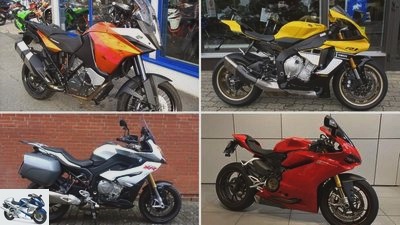
1000PS marketplace app
These motorcycles are available in large numbers.
Cornering ABS can currently only be found in premium motorcycles, for which you still have to pay quite a bit even on the used market. However, the motorcycles mentioned here are very popular and their availability on the motorcycle market is correspondingly good. Current prices are available here: Buy motorcycles with cornering ABS in Germany.
Related articles
-
MSC cornering ABS in the test in the KTM 1190 Adventure
Jahn motorcycles MSC cornering ABS in the test in the KTM 1190 Adventure MSC in the KTM 1190 Adventure put to the test ABS suitable for lean angles…
-
Cornering ABS MSC from Bosch in the test
Bosch 11 pictures Bosch 1/11 The schematic diagram shows the brake lines from the modulator to the wheel brake cylinders. Bosch 2/11 “Thank you, Dr….
-
Cornering ABS stability control for everyone
KTM 20th pictures Jahn 1/20 KTM 1190 Adventure with cornering ABS MSC from Bosch. KTM 2/20 Cornering ABS MSC from Bosch. KTM 3/20 Cornering ABS MSC from…
-
fact 23 pictures fact 1/23 Cornering ABS of the BMW HP4. fact 2/23 Cornering ABS of the BMW HP4. fact 3/23 Cornering ABS of the BMW HP4. fact 4/23…
-
Cornering ABS and traction control regulate more often than expected
Photo: markus-jahn.com 6th pictures Bosch 1/6 The so-called curve ABS at a slope of 35 degrees on dry asphalt. The driver brakes in an inclined position,…
-
Driver assistance systems for motorcycles
Hirano Ami counselor Driving experience & Driving tips Driver assistance systems for motorcycles Assistance systems For comfort and security Motorcycles…
-
Technology comparison of new supersport motorcycles 2015 – part 2
MOTORCYCLE 30th pictures manufacturer 1/30 Aprilia RSV4 RR. Aprilia is still quite stingy with pictures of the new RSV4 RR. manufacturer 2/30 Kawasaki…
-
Technology PS driving dynamics cornering ABS
markus-jahn.com 18th pictures markus-jahn.com 1/18 … as well as in the city to its limits. markus-jahn.com 2/18 On the one hand, this smooth transition…
-
2snap Sports & scene Motorsport Rossi’s cornering technique Rossi’s cornering technique Consultation with the doctor Content of Valentino Rossi chats…
-
Active safety systems in motorcycles
Bosch 10 pictures MOTORCYCLE archive 1/10 ABS – Should prevent the wheels from locking when braking hard or on slippery surfaces. KTM 2/10 “Cornering ABS…